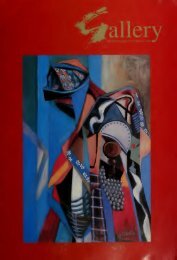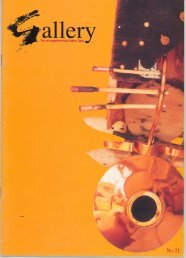Gallery : the art magazine from Gallery Delta
Gallery : the art magazine from Gallery Delta
Gallery : the art magazine from Gallery Delta
Create successful ePaper yourself
Turn your PDF publications into a flip-book with our unique Google optimized e-Paper software.
One of <strong>art</strong>'s functions is to blow open windows in <strong>the</strong> mind. Margaret<br />
Garlake sends news of <strong>the</strong> continuing discovery of new possibilities.<br />
Letter <strong>from</strong> London<br />
A few days ago I received an envelope<br />
postmarked Las Vegas, a city wliere I Icnow<br />
no-one. It contained a balloon, bearing <strong>the</strong><br />
words "If I fish a fish / You cook it / Whose<br />
fish is it?" I take this to be an <strong>art</strong>-work,<br />
albeit a modest one (as well as a statement<br />
of anxiety about gender relations). A<br />
compensation for mailing-list junk is that<br />
occasionally something serendipitous<br />
happens, like a balloon.<br />
The point is that in London people receive a<br />
great deal of information about exhibitions,<br />
most of which it is impossible to visit, while<br />
<strong>art</strong> flourishes in many o<strong>the</strong>r centres and.<br />
indeed, in places which are not centres at all.<br />
'London', <strong>the</strong>n, is not so much a place of<br />
commercial opportunity and open doors<br />
(though it may be that as well) as a wider<br />
locus for invention, <strong>the</strong> redrawing of<br />
boundaries and a constant reinvestigation of<br />
<strong>art</strong>"s roles and possibilities. And this<br />
creativity may not take place in <strong>the</strong> city at<br />
all: it may simply act on <strong>the</strong> city.<br />
The Bowes Museum, at Barnard's Castle in<br />
far-away Co. Durham was <strong>the</strong> setting for an<br />
imaginative show which foregrounded <strong>the</strong><br />
always sensitive issues of curatorial licence<br />
and <strong>art</strong>istic autonomy. The Bowes is not like<br />
o<strong>the</strong>r museums. The building is a 17th<br />
century French chateau built in <strong>the</strong> 1870s in<br />
nor<strong>the</strong>rn England to house <strong>the</strong> private<br />
collection of John and Josephine Bowes.<br />
Between 1861 and 1875 <strong>the</strong>y bought over<br />
15.000 items which range <strong>from</strong> a crust of<br />
bread said to date <strong>from</strong> <strong>the</strong> Paris Commune<br />
Anya Gallaccio,<br />
Preserve Red Beauty', 1996.<br />
(Photo courtesy <strong>the</strong> <strong>art</strong>ist<br />
& The Henry Moore Institute)<br />
i<br />
to some ra<strong>the</strong>r nice Meissen porcelain, plus<br />
furniture, paintings (often dubious) and<br />
entire 'period' rooms. The Bowes' frenetic<br />
acquisition may have had to do with a desire<br />
for social legitimation, since he was an<br />
illegitimate member of an aristocratic family<br />
grown exceedingly rich on coal, while she<br />
was a French actress. Relatively little has<br />
been added to <strong>the</strong> collections since <strong>the</strong>ir<br />
deaths, so <strong>the</strong> Museum remains largely a<br />
time-capsule, a monument to prevalent but<br />
uncertain taste and a singular lack of<br />
discrimination.<br />
Into it. two curators. Penelope Curtis and<br />
Veit Gomer inserted contemporary works by<br />
a group of disparate British and German<br />
<strong>art</strong>ists. In almost every case, <strong>the</strong> pieces were<br />
selected extremely carefully <strong>from</strong> existing<br />
work, for <strong>the</strong> interactions that <strong>the</strong>y might<br />
stimulate with specific locations in <strong>the</strong> vast<br />
expanse of <strong>the</strong> Bowes. From <strong>the</strong> random<br />
blobs of gold-painted plaster dotted around<br />
<strong>the</strong> walls and floor of a rococco room, to <strong>the</strong><br />
little wax models called English Clergy-<br />
posed in a late Gothic interior, <strong>the</strong> pieces<br />
worked as commentaries, poignant, witty or<br />
ironic, on <strong>the</strong> existing collection. It's fairly<br />
predictable that Damien Hirst's pickled<br />
sheep should nudge up to a two-headed calf;<br />
less so that both should occupy a room<br />
devoted to local industries; this p<strong>art</strong>icular<br />
sheep has not been much discussed as<br />
representative of <strong>the</strong> late Victorian rural<br />
economy. Upstairs, in a room containing<br />
inter alia a sedan chair and some indelicate<br />
French 1 8th century paintings, were<br />
Ca<strong>the</strong>rine Yass" back-lit colour photographs<br />
,-?^<br />
of <strong>the</strong> curators, contemporary versions of<br />
John and Josephine, responsible for 're-<br />
writing' <strong>the</strong> 'text' of <strong>the</strong> collection. As so<br />
often, <strong>the</strong> pieces that worked best were <strong>the</strong><br />
most discreet. Pressed between two sheets<br />
of glass forming a false interior window.<br />
Anya Gallaccio (she who a few months ago<br />
spectacularly installed a ton of ice in a<br />
disused pumping station and waited for it to<br />
melt) arranged brilliant red flowers, to decay<br />
during <strong>the</strong> course of <strong>the</strong> exhibition; in a<br />
space entirely filled with Josephine's own<br />
mediocre paintings. Gavin Turk placed a<br />
paint roller and tray, faced by its own cast in<br />
bronze.<br />
Exhibitions which are interventions into<br />
locations with strong, existing identities are<br />
not unusual. It is, however, extremely rare<br />
to find curatorial authority exercised with<br />
such acutely intelligent imagination and<br />
insight. Because of this, <strong>the</strong> <strong>art</strong>ists agreed to<br />
allow <strong>the</strong>ir works to be sited in situations<br />
which <strong>the</strong>y had not envisaged, to convey<br />
messages not of <strong>the</strong>ir makers' devising.<br />
An organisation called Space Explorations<br />
took a different approach, on a smaller scale.<br />
when <strong>the</strong>y organised an exhibition in a<br />
London tower block awaiting demolition.<br />
Derelict factories, warehouses and office<br />
blocks are regularly snapped up for short-<br />
term use by <strong>art</strong>ists as an alternative to scarce<br />
and inaccessible commercial gallery spaces.<br />
'High-Rise" used six floors and <strong>the</strong> basement<br />
of a block next to <strong>the</strong> new British Library:<br />
one <strong>art</strong>ist to a floor, working to a clear<br />
directive, each one to produce one piece I /







